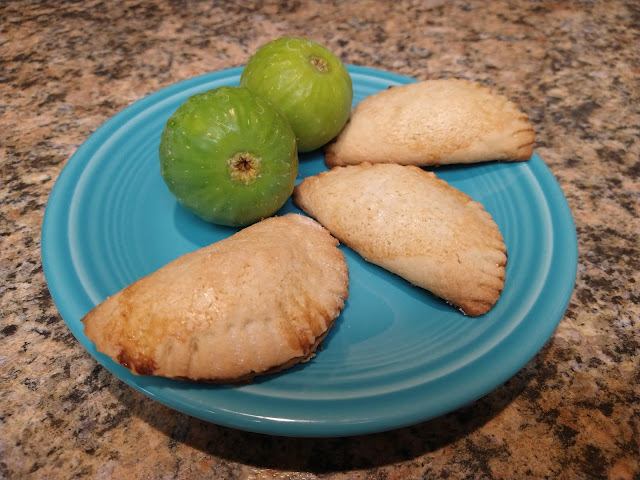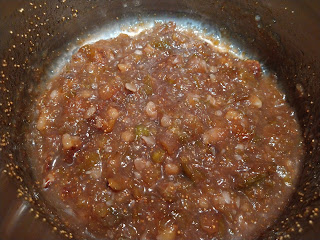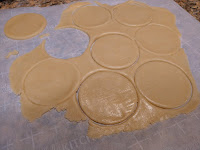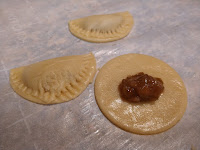
Recipe: Fig pockets are filled with quick fresh preserves

|
Like fig season, these cookies are special. They take a little time and effort, but the results are delicious with a delicate crispness and just the right amount of fig.
Filled with quick fresh fig preserves, they’re like mini turnovers. Instead of a flaky crust, the golden pastry forms something closer to a scone. Removed from the oven at 8 minutes, the dough stays soft like a thick sugar cookie with a fig center. Two minutes more, the top is golden and the bottom crisps while the filling retains its softness. (Any longer and the cookie gets too crunchy.)
The pastry dough needs to be kept as cold as possible; otherwise, it sticks to everything while being worked and pulls apart. So, make these little pastry pockets in batches of 10 or 12.
 |
|
| Quick fresh fig preserves double as filling. |
For the fig filling, finely chop the figs including skin. (The food processor is great for this.) Walnuts add a little extra texture and flavor, but are optional. You’ll have extra fig filling leftover. Use those quick fig preserves on toast or English muffins. Or make more cookie dough!
Fig pockets
Makes about 30 cookies
For pastry:
6 tablespoons shortening
¾ cup sugar
2 eggs, lightly beaten
¾ teaspoon vanilla
2 cups flour
½ teaspoon salt
¼ teaspoon soda
For filling:
1-1/2 cups figs, finely chopped (about ½ pound)
2/3 cup sugar
2/3 cup water
1/3 cup walnuts, finely chopped (optional)
To assemble:
1/4 cup milk
3 tablespoons sugar
Prepare pastry dough. With a pastry blender in a large bowl, cut ¾ cup sugar into shortening until fluffy. Stir in eggs, then vanilla. Sift together flour, salt and soda. Blend dry ingredients into sugar-shortening mixture. Cover bowl with plastic wrap and chill dough in refrigerator for 1 hour.
Prepare filling. In a heavy saucepan, combine chopped figs, 2/3 cup sugar, water and walnuts, if desired. Over medium heat, bring mixture to a boil, then reduce heat to simmer. Stirring often to prevent sticking, cook fig mixture until it thickens, about 10 to 15 minutes depending on the ripeness of the figs. Remove from heat and let cool thoroughly.
Preheat oven to 400 degrees F.

|
Remove chilled dough from refrigerator. Divide dough into thirds. Put one third of the dough on a sheet of parchment paper or lightly floured, cloth-covered board. Return remaining dough to refrigerator to stay cold.
Between two sheets of parchment paper or on the lightly floured board, roll dough until thin, about 1/16th inch thick. Using a 3-inch cookie cutter or the rim of a large glass, cut circles of pastry. Place 1 teaspoon of fig filling on each pastry circle. Fold pastry over filling. Use a fork to crimp the pastry and seal.
Carefully place little turnovers onto an ungreased baking sheet, leaving plenty of room between each cookie. Brush tops with milk and sprinkle with sugar.
Bake at 400 degrees for 8 to 10 minutes, or until very light golden brown. (Less for a softer cookie, longer for a crisper cookie.) Remove cookies from baking sheet immediately and cool on a rack.

|
Repeat this process until all dough is used.
These cookies can be served warm or room temperature. Store in a sealed container.
Comments
0 comments have been posted.Sacramento Digs Gardening to your inbox.
Food in My Back Yard Series
May 6: Maintain soil moisture with mulch for garden success
April 29: What's (already) wrong with my tomato plants?
April 22: Should you stock up on fertilizer? (Yes!)
April 15: Grow culinary herbs in containers
April 8: When to plant summer vegetables
April 1: Don't be fooled by these garden myths
March 25: Fertilizer tips: How to 'feed' your vegetables for healthy growth
March 18: Time to give vegetable seedlings some more space
March 11: Ways to win the fight against weeds
March 4: Potatoes from the garden
Feb. 25: Plant a fruit tree now -- for later
Feb. 18: How to squeeze more food into less space
Feb. 11: When to plant? Consider staggering your transplants
Feb. 4: Starting in seed starting
Sites We Like
Garden Checklist for week of May 11
Make the most of the lower temperatures early in the week. We’ll be back in the 80s by Thursday.
* Plant, plant, plant! It’s prime planting season in the Sacramento area. Time to set out those tomato transplants along with peppers and eggplants. Pinch off any flowers on new transplants to make them concentrate on establishing roots instead of setting premature fruit.
* Direct-seed melons, cucumbers, summer squash, corn, radishes, pumpkins and annual herbs such as basil.
* Harvest cabbage, lettuce, peas and green onions.
* In the flower garden, direct-seed sunflowers, cosmos, salvia, zinnias, marigolds, celosia and asters. (You also can transplant seedlings for many of the same flowers.)
* Plant dahlia tubers.
* Transplant petunias, marigolds and perennial flowers such as astilbe, columbine, coneflowers, coreopsis, dahlias, rudbeckia and verbena.
* Keep an eye out for slugs, snails, earwigs and aphids that want to dine on tender new growth.
* Feed summer bloomers with a balanced fertilizer.
* For continued bloom, cut off spent flowers on roses as well as other flowering plants.
* Add mulch to the garden to maintain moisture. Mulch also cuts down on weeds. But don’t let it mound around the stems or trunks of trees or shrubs. Leave about a 6-inch-to-1-foot circle to avoid crown rot or other problems.
* Remember to weed! Pull those nasties before they set seed.
* Water early in the day and keep seedlings evenly moist.